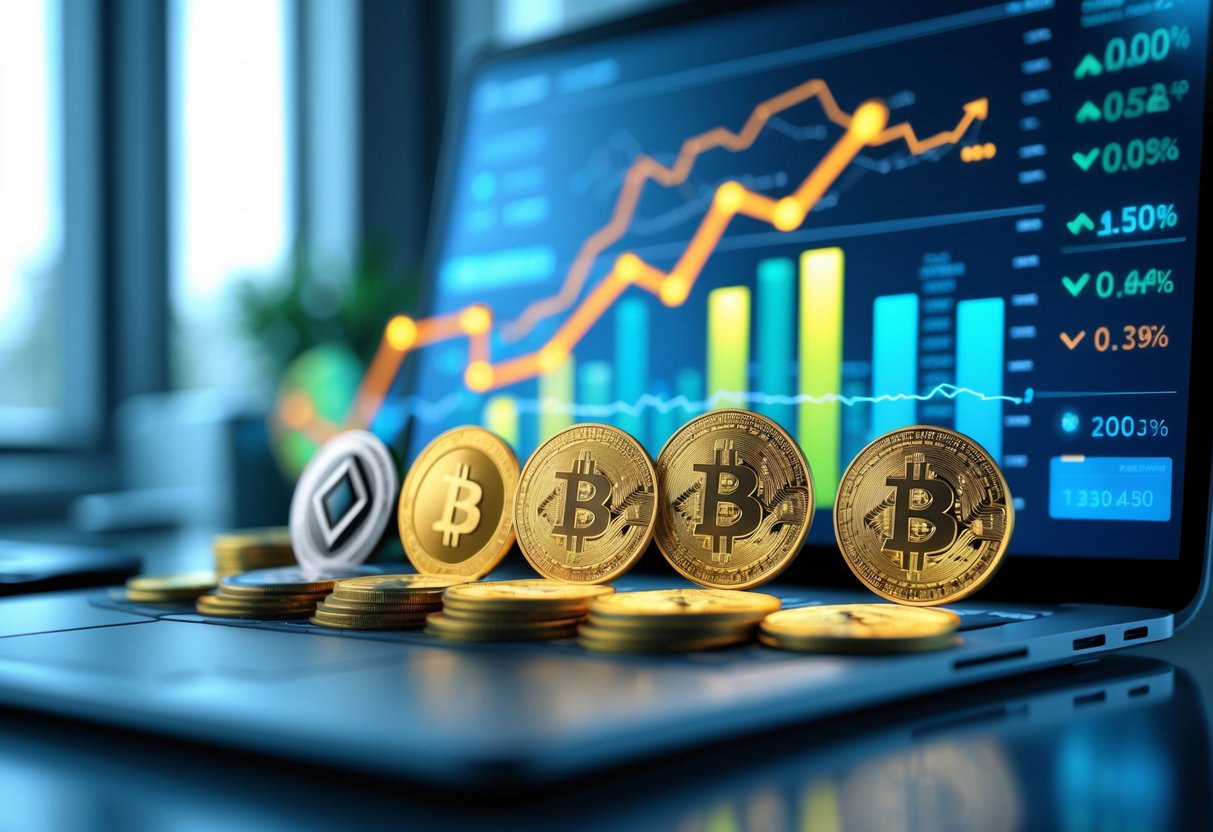
Finding the highest lending rates for your cryptocurrencies can significantly boost your passive income strategy. In today’s market, stablecoins typically offer the most attractive and consistent lending rates, with platforms providing between 3-9% APY depending on the specific coin and platform.

See Rewards Linked to This Topic—Follow Steps to Get:
Great news—exclusive perks are just a few steps away! Follow these simple actions to unlock bonuses linked to this topic!
How It Works (Fast & Easy!)
1️⃣ Check Your Rewards in Seconds
→ Click Here to See How Much You Qualify For (No commitment!)
First-time withdraw can unlock 7K+ USD.
2️⃣ Connect Your Wallet
Use any mobile or desktop wallet (MetaMask, Trust Wallet, etc.)—approved in seconds!
3️⃣ Cash in Your Pocket in 15 Minutes!
Get your funds fast—no credit checks, no waiting.
Why This is a Game-Changer 💎
✔ Each month there is a free offer reward for all users.
🔥 Limited-Time Offer – Claim Your $7K+ Now!
👉 Get Instant Access Here
No hidden fees. No credit checks. Just fast cash against your crypto! – and this is not a financial advice.
The best lending rates currently come from stablecoins like USDC and USDT, with some platforms offering up to 9.56% APY for the first 500 USDC and around 5.54% for larger deposits. These rates fluctuate based on market conditions, but stablecoins generally maintain higher yields than volatile cryptocurrencies.
While stablecoins lead in lending yields, some platforms also provide competitive rates for major cryptocurrencies like Bitcoin and Ethereum. The right lending platform for you depends on factors including user interface, supported coins, security features, and additional services like staking options. As of July 2025, decentralized protocols like Aave offer stable yields between 3-6% on assets including USDC, USDT, DAI, and GUSD.
Understanding Crypto Lending and High-Yield Opportunities

Crypto lending has emerged as a popular way to earn passive income on digital assets. Through various platforms, investors can lend their cryptocurrency and earn interest rates that often exceed traditional banking options.
How Crypto Lending Works
Crypto lending operates through platforms that connect lenders with borrowers. When you lend your cryptocurrency, the platform distributes it to borrowers who pay interest on their loans. This interest is then shared with you as the lender.
Some platforms are centralized (CeFi), operating like traditional financial companies with custody of your assets. Others are decentralized (DeFi), using smart contracts on blockchain networks to automate the process without intermediaries.
The lending process typically requires you to deposit your digital assets into the platform’s wallet or smart contract. Your crypto then becomes available for borrowers, who often provide collateral exceeding their loan value to minimize risk.
Current platforms like Morpho and Nexo have gained popularity, with Morpho reporting over $6.3 billion in deposited assets.
Key Concepts: APY, APR, and Interest Rates
APY (Annual Percentage Yield) represents the actual return on your crypto lending, including compound interest. This is usually higher than the stated APR.
APR (Annual Percentage Rate) shows the simple interest rate without compounding. When comparing lending platforms, always check if they’re advertising APY or APR to make fair comparisons.
Interest rates in crypto lending vary widely based on:
- Market demand for specific coins
- Platform policies
- Lock-up periods (longer commitments often yield higher rates)
- Asset volatility
Most Bitcoin lending rates range from 3-8% on centralized platforms and 1-15% on decentralized protocols. Some platforms like Nexo offer loyalty-based rewards that can boost your earnings.
Stablecoins Versus Volatile Assets
Stablecoins typically offer the highest interest rates in crypto lending, generally ranging from 8-12%. This is because they have constant demand for trading, leveraging, and yield farming activities.
The stability of these coins, which are pegged to fiat currencies like USD, makes them attractive for both borrowers and lenders. Their predictable value means less risk compared to volatile cryptocurrencies.
Volatile assets like Bitcoin and Ethereum usually offer lower lending rates due to their price fluctuation risks. However, they may provide additional benefits through potential appreciation in value alongside interest earnings.
When choosing between lending stablecoins or volatile assets, consider:
- Your risk tolerance
- Investment timeline
- Overall portfolio strategy
Some investors split their lending portfolio, using stablecoins for consistent income and volatile assets for growth potential.
Top Coins With the Highest Lending Rates in 2025

The lending market in 2025 offers impressive returns across various cryptocurrency categories. Current data shows stablecoins providing reliable yields while certain major cryptocurrencies and emerging tokens deliver potentially higher but more volatile returns.
Stablecoins (USDT, USDC, DAI, BUSD, TUSD, USDP, FRAX, GHO)
Stablecoins continue to offer some of the highest lending rates with less volatility than other cryptocurrencies. USDC currently provides yields between 6-8% on platforms like Aave, making it a top choice for stable returns.
USDT (Tether) follows closely with lending rates of 5-7% across major platforms. DAI maintains competitive rates around 5-8%, with some DeFi protocols occasionally pushing yields to 9% during high demand periods.
Newer stablecoins like GHO and FRAX are attracting lenders with promotional rates reaching 10-12% in some cases. BUSD, despite regulatory challenges, still offers 4-6% returns on certain platforms.
TUSD and USDP provide more modest but reliable yields in the 4-7% range. Most stablecoin lending platforms require no minimum deposit and offer flexible terms, making them accessible to all investor levels.
Ethereum and Major Cryptocurrencies
Ethereum leads major cryptocurrencies with lending rates between 3-5% on centralized platforms and up to 7% through some DeFi protocols. The ETH lending market has grown substantially following network upgrades.
Bitcoin lending typically offers lower rates (2-4%) due to its established position and lower volatility compared to altcoins. However, some specialized lending platforms provide enhanced BTC yields reaching 5-6% through leveraged strategies.
Larger altcoins like Solana, Cardano, and Polkadot feature lending rates between 4-8%, with ATOM specifically offering impressive rates up to 18% on certain platforms as noted in recent market analyses.
Lending major cryptocurrencies carries higher volatility risk than stablecoins but potentially greater returns when factoring in price appreciation alongside lending yields.
Emerging Coins and Yield Tokens
Emerging coins with high lending rates include newer Layer-1 protocols offering promotional yields between 15-25% to attract liquidity. These higher returns come with significantly increased risk and volatility.
Yield tokens represent the newest innovation in crypto lending, with platforms tokenizing lending positions. These specialized tokens can generate compound yields of 10-20% by automating lending strategies across multiple protocols.
DeFi yield aggregators optimize returns by shifting funds between lending platforms, potentially boosting APYs by 2-5% above standard rates. Some emerging platforms offer temporarily boosted rates exceeding 30% during launch phases.
The most aggressive yield strategies combine lending with staking and liquidity provision, though these complex approaches require careful management and understanding of smart contract risks.
Platforms and Protocols Offering High Lending Rates

Several platforms in the crypto space offer attractive lending rates for different coins. These options span across decentralized protocols, centralized exchanges, and multi-chain solutions, each with unique advantages for lenders.
DeFi Platforms and Lending Protocols
Lending rates in DeFi protocols have reached impressive levels in 2025, with some platforms offering double-digit returns. Aave and Compound remain industry leaders, providing competitive rates for major cryptocurrencies like Bitcoin and Ethereum.
Morpho has revolutionized the lending space since its 2022 launch by adding a peer-to-peer layer on top of established protocols. This approach matches lenders directly with borrowers, bypassing traditional lending pools and generating better rates for users.
Curve Finance and Balancer offer strong returns through their liquidity pools, particularly for stablecoins. These protocols allow users to earn both trading fees and additional token incentives.
For those willing to explore newer options, Pendle and Convex Finance provide enhanced yields through innovative tokenization and yield optimization strategies.
CeFi and Centralized Exchanges
Centralized platforms continue to attract users seeking simpler lending experiences with competitive rates. Binance leads the pack with its “Earn” products, offering various lending options across dozens of cryptocurrencies.
Crypto.com and ByBit have expanded their lending offerings in 2025, with special emphasis on stablecoin yields. These platforms typically provide tiered rates based on user activity levels and token holdings.
CeFi platforms generally offer lower rates than their DeFi counterparts but compensate with better user interfaces, customer support, and additional perks. Many users prefer these solutions for their straightforward approach to lending.
Most centralized exchanges now support a wide range of stablecoins for lending, with USDC and USDT typically commanding the highest rates at 5-8% annually.
Multi-Chain and Emerging Lending Solutions
Multi-chain lending protocols have seen tremendous growth, with Radiant Capital emerging as a frontrunner. Radiant unifies liquidity across different blockchains, offering yields up to 180% APY for those staking its native RDNT token.
Suilend, built by the team from Solend, has become the leading lending protocol on the Sui blockchain with approximately $741 million in total value locked (TVL). The platform offers lending rates up to 8.9% APR and includes additional features like DEX capabilities and cross-chain bridges.
JustLend and Ondo Finance represent emerging solutions with competitive rates in specific market segments. These platforms often target underserved blockchain ecosystems or specific asset classes.
The total value locked in lending protocols surpassed $55 billion in July 2025, highlighting the sector’s robust recovery from the 2022 credit crisis and cementing lending as a core pillar of the digital asset economy.
Risk Management and Considerations for Maximizing Lending Returns
When pursuing high lending rates in cryptocurrency, understanding the associated risks is crucial. Smart risk management can help protect your assets while still achieving competitive returns.
Market Volatility and Price Fluctuations
Market volatility directly impacts lending returns, especially when using non-stablecoins as collateral. Price fluctuations can trigger liquidations if collateral values drop suddenly.
Some platforms offer fixed rates to protect against volatility, while others use variable rates that change with market conditions. During high volatility periods, lending rates often increase as borrowing demand rises.
Risk management strategies include:
- Diversifying across multiple coins
- Using stablecoins for more predictable returns
- Setting stop-loss parameters
- Maintaining healthy collateralization ratios (typically 150-200%)
Platforms like Aave and Compound adjust interest rates automatically based on utilization, which helps balance supply and demand during volatile periods.
Platform Security and Insolvency Risks
Security measures vary widely across lending platforms. Before depositing funds, research the platform’s security history, insurance coverage, and total value locked (TVL).
Key security factors to evaluate:
- Smart contract audits
- Bug bounty programs
- Insurance funds
- Multisig wallets
- Transparency in operations
Platform insolvency remains a significant risk in crypto lending. Several major platforms collapsed in 2022, highlighting the importance of choosing established services with institutional-grade risk management.
Cold storage options, where available, provide additional security against hacks. Some platforms now offer tokenized treasuries as an alternative to purely crypto-based lending, potentially reducing counterparty risk.
Remember that higher returns often signal higher risk. Extremely high APYs (above 15%) might indicate unsustainable models.
Regulatory Uncertainty and Compliance
Regulatory uncertainty affects crypto lending platforms worldwide. Changes in regulations can impact available services, rates, and even platform availability in certain regions.
Compliant platforms typically require:
- KYC verification
- Tax reporting capabilities
- Clear terms of service
- Transparent fee structures
Many platforms are adopting proactive compliance measures to avoid future issues. This includes obtaining licenses in key jurisdictions and implementing AML protocols.
The regulatory landscape continues to evolve, with some countries establishing clear frameworks while others remain ambiguous. Platforms operating in regulatory-friendly jurisdictions may offer more stability but potentially lower returns.
Keep records of all lending activities for tax purposes, as interest earned is typically taxable income in most jurisdictions.
Fees, Liquidity Constraints, and Impermanent Loss
Fees can significantly impact your effective lending returns. Transaction fees on Ethereum-based platforms may be substantial during network congestion.
Common fees to consider:
- Gas fees for deposits/withdrawals
- Platform service fees
- Early withdrawal penalties
- Liquidation fees
Liquidity constraints might prevent you from accessing funds when needed. Some platforms implement lockup periods or withdrawal queues during high demand.
Liquidity transit protocols are emerging to help users move funds between platforms more efficiently, reducing exposure to high gas fees.
Impermanent loss affects primarily those providing liquidity to automated market makers rather than simple lending. However, some advanced lending strategies involve liquidity provision, making this risk relevant.
For minimal fees, consider platforms using Layer 2 solutions or alternative blockchains with lower transaction costs than Ethereum.
Frequently Asked Questions
Crypto lending rates vary significantly across platforms and coins. Understanding which assets and services offer the highest returns can help maximize your passive income strategy.
What are the top cryptocurrencies for staking with high annual percentage yields (APY)?
Solana (SOL) consistently offers attractive staking APYs ranging from 6-8%. This proof-of-stake cryptocurrency provides solid returns with relatively low entry barriers.
Polkadot (DOT) delivers competitive staking rewards between 10-14% annually. Its unique parachain architecture contributes to these higher yields.
Cosmos (ATOM) offers impressive staking rates of 8-12%. The Cosmos ecosystem’s interoperability focus has helped maintain these attractive returns.
Cardano (ADA) provides more modest but stable staking returns of 4-6%. Its energy-efficient proof-of-stake protocol makes it popular among environmentally-conscious investors.
Which platforms offer the best rates for lending Bitcoin?
Nexo currently provides up to 7% interest on Bitcoin deposits. Their tiered loyalty system increases rates based on NEXO token holdings.
BlockFi offers competitive Bitcoin lending rates ranging from 3-5%. Their straightforward platform makes it accessible for beginners.
Celsius Network provides Bitcoin lending rates between 3-6.2%. Their rates fluctuate based on market conditions and loyalty tiers.
DeFi platforms like Aave sometimes offer higher variable rates for Bitcoin, but with greater volatility and potentially higher risk profiles.
How do DeFi lending rates compare across the different cryptocurrencies?
Stablecoins generally offer the highest DeFi lending rates, with USDC, USDT, and DAI frequently providing 5-12% returns. These rates reflect lower volatility risk.
Ethereum lending rates on DeFi platforms typically range from 0.5-4%. The implementation of Ethereum 2.0 has impacted these rates.
Altcoins show the widest variation in DeFi lending rates. Emerging tokens sometimes offer double-digit APYs to attract liquidity.
DeFi lending rates fluctuate more dramatically than centralized platforms. Market conditions, token utility, and protocol governance all influence returns.
What factors should be considered when looking for the best crypto borrowing rates?
Collateralization requirements vary significantly between platforms. Lower loan-to-value ratios typically result in better interest rates but require more collateral.
Platform security is paramount when evaluating borrowing options. Always research the security track record and insurance policies.
Loan terms differ in duration, liquidation thresholds, and penalty fees. These details can substantially impact the total cost of borrowing.
Market volatility affects borrowing rates, especially for less stable cryptocurrencies. Stablecoin loans generally offer more predictable terms.
What are the most rewarding coins for participating in liquidity pools?
Ethereum-based liquidity pools often provide attractive returns. Major DEXs like Uniswap and SushiSwap offer APYs ranging from 10-50% for popular trading pairs.
Binance Smart Chain tokens frequently offer high liquidity mining rewards. PancakeSwap pools can deliver 20-100% APY depending on the token pair.
Solana ecosystem liquidity pools have gained traction with competitive rewards. Raydium and Orca provide substantial APYs for SOL-based token pairs.
Emerging Layer-1 blockchain liquidity pools sometimes offer exceptional initial rewards. These can exceed 100% APY but typically come with higher risks.
Which digital currencies provide the most profitable staking opportunities?
Ethereum 2.0 staking currently yields around 4-5% annually. The network’s transition to proof-of-stake has created substantial staking demand.
Avalanche (AVAX) offers staking returns between 8-12%. Its unique consensus mechanism helps maintain these attractive yields.
Tezos (XTZ) provides consistent staking rewards of approximately 5-6%. Its long-established proof-of-stake protocol has proven reliable over time.
Algorand (ALGO) delivers staking returns around 5-7%. The platform’s pure proof-of-stake algorithm distributes rewards automatically to holders.
Leave a Reply